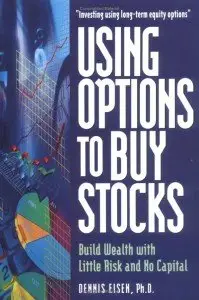Using Options to Buy Stocks: Build Wealth With Little Risk and No Capital
Dearborn Financial Publishing (February 2000) | ISBN: 0793134145 | PDF | 338 Pages
Dearborn Financial Publishing (February 2000) | ISBN: 0793134145 | PDF | 338 Pages
Jim Rogers, George Soros' former partner, onced admonished against the use of put writing, a financial instrument which brought him catastrophic losses early in his extraordinary career. Of course, LEAPS puts did not exist at the time Rogers was making use of them, and one wonders what he might think, or might have done, with Dennis Eisen's book, which makes a compelling case for LEAPS put writing.
This book is a singular, well conceived investment strategy lesson in several respects. It's rare that such a book can captivate an audience of beginning, intermediate and advanced investors, but I suspect investors of just about any caliber will find this worthwhile reading. That is to say, most readers will likely find something new here about calls and puts (both the regular option and LEAP flavors), although the author does well to stick more or less exclusively to LEAPS put writing. Also, the author uses historical runs to substantiate the tactics he's advising, which make his claims all the more informed and interesting.
Eisen addresses the key issues of rate of return, risk, and probability exceedingly well, and he contributes something altogether new to the field –probability tables, based on an issue's earnings growth and volatility. The author also addresses the proper allocation of margin, option taxation, and gives a decent explanation of option volatility. The book's essential and recurrent theme is that LEAPS puts tend to completely disregard an underlying issue's earnings growth potential.
The book's essential shortcoming is that its underlying option pricing formula, which accounts for stock dividends and American style options unlike the European-styled Black-Scholes model, is delineated for copy in the text as a BASIC program rather than as an EXCEL spreadsheet. Unless the reader is using BASIC, which seems unlikely to me, he or she will find the awaiting transcription task a substantial chore. And the volatility calculation Eisen suggests is based on a year's worth of an underlying issue's price data. The book might have included a macro spreadsheet for all of the requisite data and calculations, or the author might have made such a spreadsheet available for extra cost, which I –and I am sure many others– would gladly pay.



